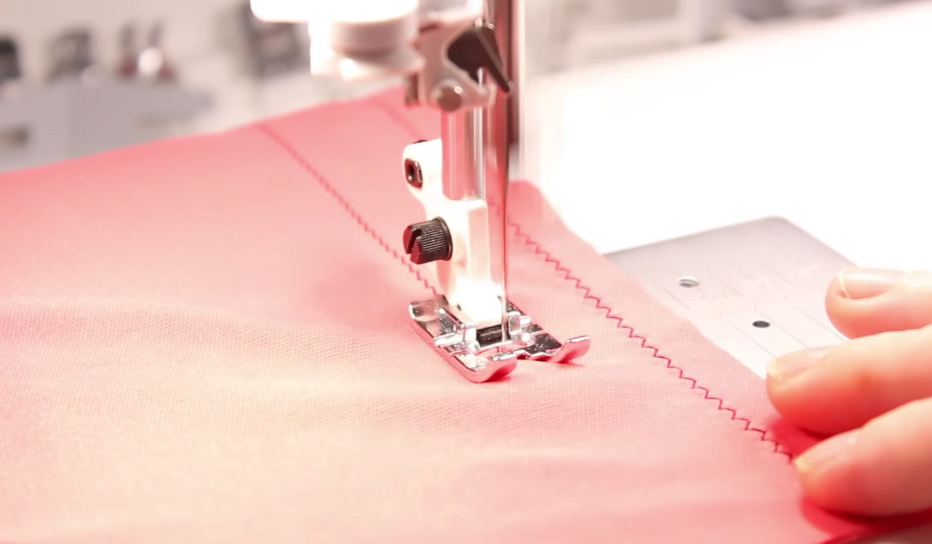Does sewing with stretchy fabric give you a headache? Have you ruined numerous sewing projects trying to master a seemingly impossible skill? Are you baffled as to how to stop your fabric puckering?
Fear not sewists and crafters! With a few tricks up your sleeve, you will soon have the confidence to tackle any project using stretchy fabric.
How To Sew Stretchy Fabric Without Puckering
Can You Sew Stretch Fabrics On A Domestic Sewing Machine?
Many people think that you need an overlocker to be able to sew stretchy fabrics at home. Whilst this will make the process quicker and easier it is not necessary. For the hobbyist sewer, the extra expense of an overlocker is not always needed.
Following the tips below will help you understand more about sewing with stretchy fabrics on a domestic sewing machine and the tools you will need to accomplish the task. Your end projects will be pucker-free, neat and the seams will not break when in use.

However, you should also make sure that you’ve got the right stitches at your disposal. Many modern sewing machines, like the Babylock Brilliant, come with stitches specifically made to sew stretch fabrics and save you the cost of purchasing an overlocker.
What Needle To Use For Stretch Fabrics?
Using the correct needle in your sewing machine is important for any project but especially when sewing stretchy fabrics. There are three types of needles to choose from when sewing stretchy fabric:
Ballpoint Needle
The ballpoint needle has a rounded tip, which is designed to avoid breakage in the fibers for knits and spandex fabrics. It goes between the fabric fibers rather than cutting them, and it’s a good choice for cotton knits, tricot, jersey knits, and swimwear fabrics.
Twin Needle
The twin needle is needed for hemming stretch fabrics. It creates a professional and tidy appearance on knits and other stretch materials you’d see in a retail store.
However, it’s also useful for sewing knits without a serger. That’s because the twin needle sews in two parallel lines of stitching, as the thread zigzags between them – creating a stronger stitch which will stretch with your fabrics and prevent ripping.
The twin needle also creates a stitch which brings the fabric together rather than pulling it apart, which is what often causes the fabric puckering which you’ve experienced.
What Thread To Use For Stretch Fabrics?
Choosing a thread not suited to stretch fabric will cause your fabric to pucker and it may snap when the finished item is in use. A good choice of thread is polyester, it is strong, ideal for constructing garments, and does have a small amount of stretch. Do not choose cotton thread as it is known to break easily and will likely cause you issues.
Which Sewing Foot For Stretch Fabrics?
To stop your fabric from puckering a walking foot is essential. They look complicated but after a bit of practice, you will be glad you invested in one. They have built-in feed dogs, like the ones usually found under your fabric when sewing, they move your fabric at the same speed as your sewing machine, causing less stretch to the fabric and even feeding.
Best Stitch For Stretchy Fabric
If you want to sew stretch fabrics on a home machine – it’s helpful to a few specialty stitches at your disposal. A straight stitch will just unravel when your garments try to stretch, but the below stitches will hold things together tight!
Zig Zag Stitch
The number one most important stitch for stretch fabrics is the zig zag. This reinforced stitch has a bit of give to it, and it works great on all kinds of materials and in many different situations. It can be used for almost anything, but doesn’t look as tidy as some other stitches on necklines.
Narrow Zig Zag Stitch
A narrow Zig Zag is a bit neater than the regular Zig Zag, and it works wonderfully on things like spandex. It has just enough give in it to protect your projects without looking homemade.
Lightning Stitch
The lightning stitch can be a great choice for hemming, but it’s also a go-to on heavier stretch fabrics that need something a bit more durable.

Choosing The Thread Tension For Stretch Fabrics
Choosing the wrong thread tension setting can also lead to puckering. Now, depending on your specific fabric.. different thread tensions may work better than others. However, a lower thread tension level works best to avoid puckering.
You may want to test out a few different settings on some scraps to see which one produces the best result for you and the fabric that you’re trying to sew before you jump into a project head first.
How To Cut Knit and Stretch Fabrics
One of the most important steps to take before sewing your stretchy fabric is making sure you have cut it out correctly. Washing your fabric before cutting eliminates any surprise shrinkage later on.
When cutting your fabric make sure you think about the direction of the stretch and as this will impact your finished item. You won’t have this issue with 4-way stretch fabric as it will stretch the same in all directions.
Layout your pattern pieces and pin them in place. Keep your pins within the seam allowance to ensure they don’t leave any holes in visible places on the garment; this can be common with thinner fabrics.
When cutting, make sure to use a large work area so you don’t accidentally stretch your fabric while cutting. To stop fabrics such as knitted jersey curling when being cut you can use a starch spray and press the edges to help them lay flat.
Sewing Machine Settings For Stretch Fabric
Choosing the right settings on your machine is essential. That’s because using the wrong stitch or settings on stretch fabric like this destroys a project. Check the table below to see what you need.
Light-weight fabrics would be things like sheer, medium weight would be jersey, and heavy-weight would be sweaters, double knits, neoprene, etc.
| Light-weight | Medium-weight | Heavy-weight | |
| Sewing | Triple ZigZag Stitch Width: 6 Length: 1 | ZigZag Stitch Width: 6 Length: 1.5 | Lightning Stitch Width: 0.5 Length: 4 |
| Hemming | Lightning Stitch Width: 0.5 Length: 4 | Triple Stretch Stitch Width: 0 Length: 4 | Triple Stretch Stitch Width: 0 Length: 4 |
PS. Have You Tried The Tissue Paper Trick?
If you are still having problems with your fabric puckering you can try placing some tissue paper on top of the fabric to help stabilize it. It stops the fabric from moving around and stretching whilst sewing and can easily be torn away afterward.
In short, while stretch fabrics do take more planning and a proper set up – they are very do-able for the home sewist! If you’re having issues, then you may want to move your focus to some easier beginner projects while you level up your skills.
Practice, patience, and planning are the keys to success here. Don’t rush sewing with stretch fabrics or you’ll quickly become frustrated. Take your time and be kind to yourself as you learn and you’ll be a pro at this before you know it!

Tanya, both a nurturing stay-at-home mom and a skilled crafter, is the creative force behind our blog. As the co-founder of Romney Ridge Farms & Crafts, she’s the editor and curator. She also runs the Romney Ridge Farms & Crafts social media accounts where we post new patterns for you to enjoy.



